11 Tips on How to Achieve a Sub-100-Day Thru-Hike
By Quoc Nguyen
In 2014 and 2015, I thru-hiked the Te Araroa in 95 days, the Pacific Crest Trail in 98 days, and the Appalachian Trail in 90 days. Surely, I must be some kind of super athlete to achieve thru-hikes in under 100 days?! The truth is I am not.
I’ve never played competitive sports in school, and my friends know I’m terrible at every sport. I must be a runner then? No, I hate running. Also, you will never find me in a gym – ever. Hopefully that’s enough to establish that I’m merely human.
After the PCT, I learned that sub-100-day thru-hikes were actually rare on any of these trails. It’s been done plenty of times before, but it seems to be only 2-3%. I disagree that it’s as hard as made out to believe, so I want to share some tips regarding what I did and what I observed.

1. Hit the ground running
A 100-day pace requires you to start the trail in excellent shape. Doing only the typical miles in the beginning adds up to a difference of a few days. You need to hit the necessary miles per day (mpd) immediately. The math is simple regarding the daily miles you need to make, e.g., PCT is 2,660 miles / 100 days = 26.6 mpd. Then add 3-5 miles for town stops, so you need to hike about 30 miles on a regular day for the PCT.
Training is required to walk such miles at the start, and I think the best way to train for thru-hiking is hiking. Still, no matter how hard you train, it’s nearly impossible to start a trail with trail legs. The goal is to minimize how many days of suck (soreness, blisters, swollen feet, etc.) you’ll experience in the beginning, so you can start hitting the necessary mpd and not have to make up too much time later.
2. Hike early and end late
This is the most important tip to hiking a lot of miles consistently everyday. All thru-hikers who are making big miles are earning them by walking longer hours. Maximize your daily miles by starting your day as early as possible and stopping late. However, being able to literally hike all day, even with trail legs, is difficult to sustain day after day and comes from experience.
For me, I generally hit the trail an hour after first light and walk until 30 minutes before dark. If the days are longer, I’ll walk longer, but I like to walk at least 12 hours everyday.
It’s a common misconception that most of the fastest hikers are hiking at a unreal pace to make big miles. In truth, they are simply walking more hours.
3. Keep your hiking consistent
There is no one right way to hike, but whatever your style is, you should be able to maintain it all day and do it every day consistently. Your hiking style shouldn’t wipe you out at the end of the day and make you too tired the next morning. Otherwise, this will result in inconsistent miles and unnecessary neros/zeros.
Keep in mind that it’s not necessary to hike faster than your normal pace. The faster you hike, the more breaks you have to take. I rarely hike faster than 2.5-3 mph, and this pace is only average for thru-hikers. Though, I do sustain this pace the entire day without having to take any real breaks besides my dinner break.

4. Pack light
A lighter pack always makes hiking easier – equals more miles, less effort. Do research about what gear you actually need and how to lighten your pack. Having to replacing gear on the trail is a waste of time and money. But packing too light without enough comforts will result in wasting time in town to recover mentally from trail hardship. The ideal weight-comfort balance is something each hiker has to figure out himself.
Also, you don’t have to be ultralight to thru-hike in under 100 days. Some of the fastest thru-hikers I’ve met were ultralight but some had an average base weight, including me.
5. Take neros not zeros
It’s necessary to spend time in town to run errands and take a break, but taking an entire day off the trail really kills your average. Having to make up a full day of hiking is more difficult than making up a half day.
The extra time you’ve earned from hiking more than the necessary mpd can be spent in town, so you won’t have to make up any miles – or only some miles. Ideally, you should get back on the trail after completing your town needs (resupplying, showering, charging electronics, eating a meal, etc.). But it’s fine to spend more time in town or take a zero when it’s necessary. I took a few zeros: 0 for TA, 4 for PCT, and 2 for AT.
6. Arrive in town on time
Plan your next resupplies in advance, and hike accordingly to avoid arriving when businesses are closed, i.e., nights and maybe weekends. This saves time not having to wait until the next day(s) for everything to open.
If you anticipate arriving in town at night, hike faster to get to town during business hours; this may require increasing your mileage for several days. Also, plan ahead to avoid getting stuck at the post office to send or receive mail drops. If you order gear online, avoid wasting time by anticipating its arrival date and your arrival date.
7. Eat on the go
Save a lot of time by eating while you’re walking instead of taking unwanted breaks to sit down and eat. This method works well to sustain your energy throughout the day given the huge amount of calories a thru-hiker burns.
I eat on the go the entire day except for a 30-minute dinner break and while at camp at the end of the day.
8. Eat dinner early
The hardest miles to hike are at the end of the day, but this can be overcome by eating dinner early then hiking a few more miles. Use this energy boost to hike afterwards instead of wasting it. The last miles will be easier to hike after a meal compared to hiking on an empty stomach to camp.
Dinner time used to be 1-2 hours before camp for me, but now it’s around 4 p.m. I use this meal to sustain me until night, and then I eat more at camp.
9. Don’t stop to filter water
I used to do this on my first thru-hike, and it’s really time consuming to do everyday. Rather, drink water straight, or use chemical treatments – or add a filter to an inline system or water bottle.

10. Do more dry camping
It’s nice to stop early to camp near a water source, but it is unnecessary and may cost miles. Instead, carry enough water near the end of the day, and stop hiking when it’s your usual time.
11. Be ready for the tough days
Living in the wilderness won’t always be so peachy, so it’s important to be prepared for situations I call “morale killers.” All thru-hikers will experience hardship that will test our mental toughness, but going at a 100-day pace, you don’t have the luxury to stop walking on tough days. While everyone is different, you must know how to deal with your morale killers.
For example, I’m ready to hike through mosquito hell or endless rain at any time. My bug setup (wind breaker, wind pants, head net) completely protects me whenever I encounter them. And my rain system (umbrella and quick-dry clothes) allows me to deal with hiking in the rain for days.
Quoc Nguyen, a.k.a. Double Magic, was born in Vietnam and now hails from Littleton, Colorado. He has a BSBA from the University of Colorado Denver and a JD from the University of Denver. His life is mostly hiking—whether that’s for peak bagging or thru-hiking. The Colorado mountains are his beloved playground and he’s currently chasing his dream to climb all the 13ers. This summer, he’s also completing the last of his Triple Crown of thru-hiking, the CDT.
